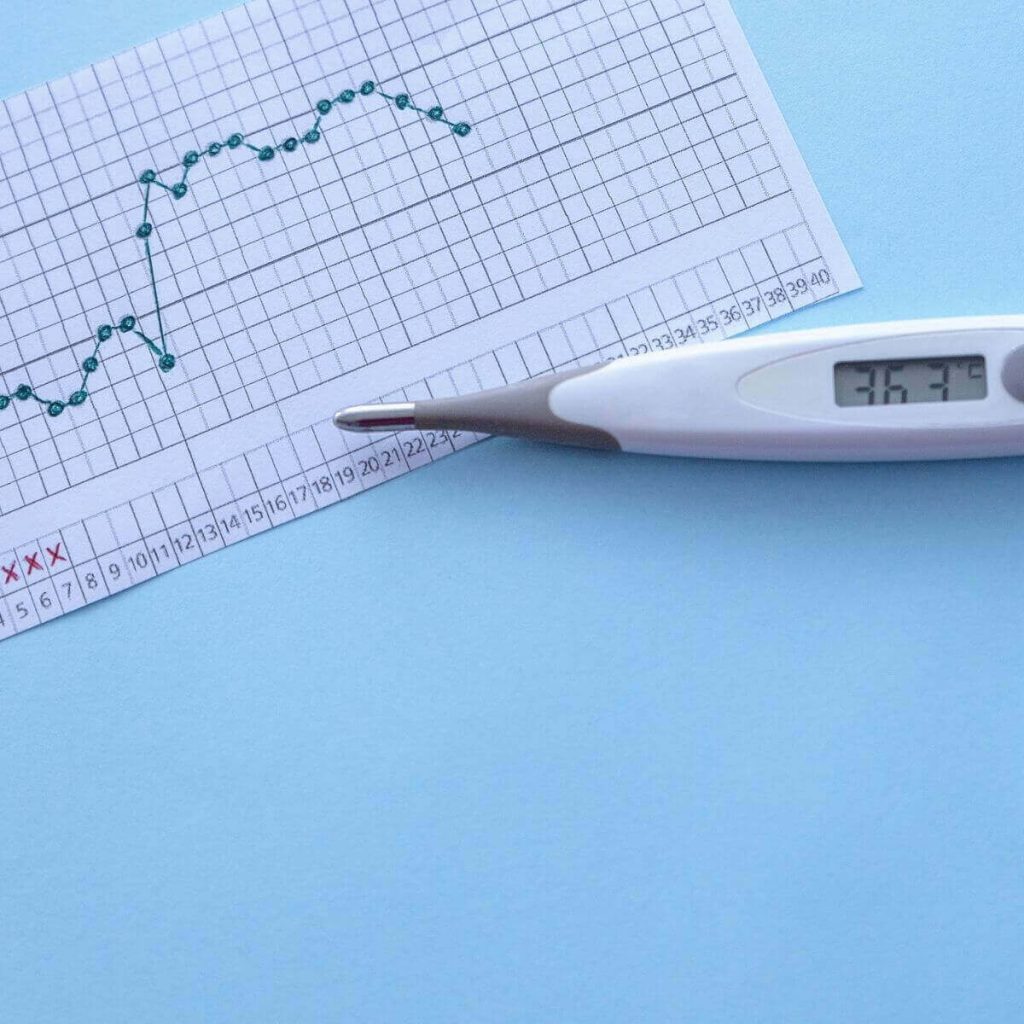While old wives’ tales about conception have a certain amount of intrigue, the one thing they don’t always offer is reliability.
If you want to improve your chances of getting pregnant naturally, it’s best to rely on trusted techniques, such as the basal body temperature method.
Sure, there are tons of modern fertility tracking methods you could try instead, like period trackers online or ovulation tracker apps. Still, these don’t provide the first-hand information you’ll get with a basal body thermometer.
Before you jump into fertility testing for women, why not learn more about how basal body temperature and ovulation go hand-in-hand?
Using the basal body temperature method might just be the simple solution you’re looking for to help you start the family you’re dreaming of.

This site contains affiliate links, meaning that we earn a small commission for purchases made through our site. We only recommend products we personally use, love, or have thoroughly vetted.
- What is the Basal Body Temperature Method (BBT)?
- How Does a Person’s BBT Help Them Conceive Naturally (Or Avoid Getting Pregnant?)
- Is Basal Body Temperature Always Reliable? Not if You’re Suffering From These Conditions
- What Should Your Basal Body Temperature Be at Various Times?
- So How Does it Work? Taking Your Basal Body Temperature the Right Way
- The Best Tools For When You’re Using the BBT Method to Get Pregnant
- Using the Basal Body Temperature Method to Start Your Family (Or to Keep Buns Out of Your Baby Oven!)
What is the Basal Body Temperature Method (BBT)?
For decades, women have used the basal body temperature method as a natural family planning technique.
What is your basal body temperature, you might be wondering?
A woman’s BBT is her “lowest, natural, non-pathologic body temperature” taken after resting for a significant amount of time – usually when she first wakes up in the morning.
On average, a woman’s basal body temperature is between 97 and 97.5°. At various times of the month, however, this temperature may slightly rise and fall.
Fluctuations in this temperature can provide insight into what’s happening inside your body. For example, people are usually most fertile in the days following their highest temperature spike of the month. Once the temp starts to decline again, it’s a sign ovulation has ended.
While your BBT is technically the same as your normal temperature, it’s essential to note it’s your body’s resting temperature.
Once you begin to move, the numbers on the thermometer will not remain the same, so tracking your basal body temperature first thing in the morning is imperative.
How Does a Person’s BBT Help Them Conceive Naturally (Or Avoid Getting Pregnant?)
Whether you’re hoping to avoid condoms and birth control but don’t want to get pregnant, or you’re hoping to conceive more quickly, the basal body temperature method is an ideal way of doing just that.
Many ovulation tracker apps even include sections where people can input their daily temperature readings to gauge what’s happening with their cycle.
Since your resting temperature will usually spike during ovulation, this can help you determine whether you should (or should not) be having unprotected sex. This temperature change is caused by the release of progesterone hormones that occurs when women ovulate.
Often, hopeful parents will combine analyzing their basal body temperature for ovulation with cervical mucus readings. This is because variations in cervical mucus also indicate particular stages of a woman’s reproductive cycle.

Is Basal Body Temperature Always Reliable? Not if You’re Suffering From These Conditions
In a perfect world, we could utilize the basal body temperature method to help us conceive. Regretfully, though, it’s not always a trustworthy option.
Please know that if you are struggling with infertility-related issues, you might not get dependable readings.
Personally, when I tried to use the BBT method to conceive, it felt like my temperature was on a rollercoaster at times – thank you, PCOS infertility!
It’s essential to understand how different fertility struggles might affect your basal body temperature before relying on this technique as your preferred natural family planning solution.
Irregular Periods
Studies have shown that women with irregular period cycles may also deal with irregular ovulation cycles. In cases like these, the basal body temperature method might not be a reliable option. If you’re confused about the consistency of your menstrual cycle, you might want to consider trying a period tracker app.
PCOS
There’s no denying that getting pregnant with PCOS naturally can be a challenge. Since 7% of the women in the world are diagnosed with this condition, finding solutions is crucial. Unfortunately, the basal body temperature method isn’t always the most trustworthy option for those of us (like me) who live with PCOS.
PCOS can make it hard to chart basal body temperature and ovulation. For one, many women who have PCOS have higher temps later in their cycle than those who do not have PCOS.
Anovulation
Some doctors will suggest that you try the basal body temperature method before going on to other fertility testing and treatment. They use BBT readings to determine whether ovulatory-related conditions are factors in your inability to get pregnant.
If you aren’t experiencing typical temperature shifts throughout your cycle, this could indicate that you’re not ovulating at all – a condition known as anovulation.
Low Ovarian Reserve
Since women with a diminished ovarian reserve can have a shorter follicular phase, this, in turn, affects various elements of their reproductive cycle. One of these is their basal body temperature. While there are times when the BBT method might work for you if you have low ovarian reserve, it’s not usually a suggested family planning technique.
Other Factors that Can Disrupt the Basal Body Temperature Method
Infertility conditions aren’t the only things that can affect your basal body temperature fluctuations. Please keep in mind the following situations can cause unusual disturbances in your normal basal body temperature chart:
- Alcohol
- Stress
- Oversleeping
- Fevers and Illnesses
- Shift Work
- Travel
- Various Medications
What Should Your Basal Body Temperature Be at Various Times?
So, we’ve already established that the average basal body temperature should be around 97 – 97.5° for most of the month. What about when you’re ovulating, though? What should your basal body temperature be if you conceive?
- Basal Body Temperature During Ovulation: Most women’s basal body temperature is between 97.6 – 98.6° while ovulating.
- Basal Body Temperature During Implantation: If implantation occurs during your cycle, you might experience a one-day “implantation dip” where your BBT will drop to between 97.6 – 97.9°
- Basal Body Temperature During Early Pregnancy: Your temperature will remain between 97.6 and 98.6° for around 18 days after ovulation if you successfully conceive.
- Basal Body Temperature During a Miscarriage: In the unfortunate event you lose your pregnancy, your BBT might remain high during and immediately after the miscarriage takes place before it starts to decline.
So How Does it Work? Taking Your Basal Body Temperature the Right Way
Now for the fun part – how exactly should you calculate basal body temperature? Well, let’s just say you’re about to be on closer, personal terms with your thermometer.
While you can use a standard oral thermometer to build your basal body temperature chart, these don’t always offer the sensitivity required to get precise readings. Many experts suggest using specific basal body thermometers.
Some of these require oral readings, but others need vaginal (or even rectal) readings.
Whichever type of thermometer you use, there are a few things to keep in mind to ensure you get consistent readings each day:
- Try to take your temperature at the same time each day.
- Use the same tool and method for all of your readings.
- Take your BBT as soon as you wake up, but before you do ANYTHING else. That includes talking, drinking, walking, or even standing up.
- Follow the directions on the thermometer exactly – many require you to keep the device in place for five minutes.
- Make sure you have AT LEAST three hours of sleep before taking your temperature.
Tip: Keep your thermometer right next to you on a bedside table for easy access in the mornings and to help remind you to take your temp before you even stumble to the bathroom (or pour yourself a cup of ambition).
The Best Tools For When You’re Using the BBT Method to Get Pregnant
Now it’s time to get down to the fun stuff – figuring out what tools you need to utilize the basal body temperature method correctly.
We’ve asked different members of our staff and community for their picks, and these are the most popular options on the market:
1. Femometer Smart Basal Thermometer
Not only does the Femometer Smart Basal thermometer come in a gorgeous rose gold design, but it’s also one of the most trusted options for women looking to use the BBT method for family planning.
It has almost 2,500 reviews on Amazon and comes with a convenient app to help you create a digital basal body temperature chart.
2. Femometer Digital Basal Thermometer
Another product by Femometer, this digital thermometer is easy-to-use and, probably best of all, affordable!
It can predict your basal body temperature within 1/100th of a degree.
3. Easy@Home Digital Basal Thermometer
One of our favorite things about the Easy@Home basal body thermometer is its blue, backlit screen.
Since you’ll be taking your temperature readings first thing in the morning before you get out of bed, it’s likely to be dark. With its light, it’s not only easy-to-read but also incredibly accurate.
4. Tempdrop Fertility Monitor
Are you worried that you’ll continually forget about taking your temperature in the morning? Do you foresee days of climbing out of bed only to sneak back in and pretend you didn’t move pre-temperature taking (that was me – I did that).
If the answer is yes, the Tempdrop Fertility Monitor might be for you!
Instead of taking your basal body temperature after waking up, you’ll place their innovative armband on before going to sleep at night. It’s connected to an app on your phone and can monitor your temperature all night long.
Using the Basal Body Temperature Method to Start Your Family (Or to Keep Buns Out of Your Baby Oven!)
Whether they’re taking it vaginally, orally, or rectally, women have trusted the basal body temperature method for ovulation for decades. Just make sure to talk to your doctor about whether or not it’s right for you, especially if you know that you have issues with your fertility that might prevent you from using BBT to conceive.
If you’re concerned about your ability to get pregnant, this technique could be a great first step in starting your family.
It might seem surprising that your body temperature can provide so much insight into the things happening inside your body, but the impressive reality is that they do!
Have you used the basal body temperature method to conceive? How did it work for you?















